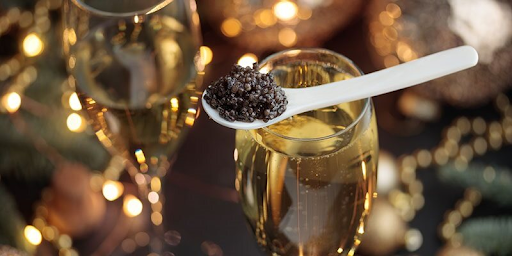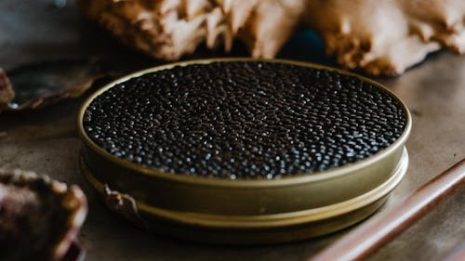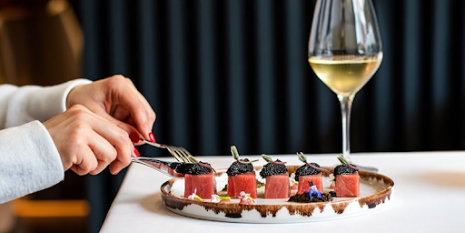
7 Steps For Eating Caviar Properly
Caviar is a little spoonful of luxury that makes any occasion feel special. If you’ve ever wondered how to savour those tiny pearls of opulence like a seasoned gourmand, you’re in the right place. Whether you’re a caviar connoisseur or a curious newbie, this guide will walk you through the essentials of how to eat caviar like a pro.
We’ll cover everything from selecting the best utensils to use, the perfect pairings, and all the tips you need to eat caviar properly. We’ll also address some common mistakes when eating caviar and how to avoid them so that even a beginner can appreciate caviar like an expert. So, grab your blinis and bubbly and let’s make your next caviar tasting a truly unforgettable event!
How To Eat Caviar Properly At Home
Eating caviar is an indulgent experience that requires a bit of finesse to fully appreciate its luxurious qualities. Follow our step-by-step detailed guide to master the art of caviar tasting!
Step 1: Choosing the Right Utensils
The right utensils preserve the delicate flavour of caviar. Traditional metal spoons can react with the caviar, imparting an undesirable metallic taste. Instead, use spoons made of mother-of-pearl, bone, horn, or even gold. These materials are inert and won’t affect the flavour of the delicate eggs.
Step 2: Serving Temperature
Caviar should be served chilled, ideally between -2 to 0°C (28-32°F). Proper temperature maintains the caviar’s texture and freshness. Too warm and it becomes mushy and loses its texture; too cold and it loses flavour. Freezing it can damage the eggs.
To keep it cool during serving, place the caviar on a bed of crushed ice.
Step 3: Opening the Tin or Jar
Use a caviar key or a small, blunt knife to carefully open the container. Avoid using excessive force which could crush the delicate eggs. The goal is to maintain the integrity of each bead.
Step 4: Presentation
Simple presentation allows the caviar’s flavour to shine without overwhelming it with other tastes. Traditional bases include blinis (which are small savoury pancakes), toast points, or unsalted crackers. These neutral carriers allow the taste of the caviar to be the main focus. Add small dollops of crème fraîche for a creamy, slightly tangy counterpoint to the caviar.
Other classic garnishes include finely chopped red onion, hard-boiled egg (whites and yolks separated and finely chopped), and fresh chives or dill. These should be used sparingly to enhance rather than overpower the caviar.
Step 5: Tasting the Caviar
Proper tasting technique enhances the sensory experience, allowing you to appreciate the caviar’s full flavour profile. Begin with a small spoonful to truly appreciate the nuances. Some people recommend placing a small amount on the back of your hand between the thumb and index finger to warm it slightly before tasting.
Next, let the caviar rest on your tongue. Roll it gently around your mouth, feeling the eggs pop and release their flavours. Note the texture, which should be firm and not mushy, and savour the taste, which can range from briny and buttery to nutty and creamy.
Step 6: Pairing with Drinks
Appropriate beverages should complement the caviar’s taste and enhance the overall experience. Chilled vodka and dry Champagne are traditional choices. Vodka, served ice-cold and neat, has a clean taste that complements the caviar without overshadowing it. Champagne provides a crisp acidity that pairs beautifully with the rich, salty flavours of caviar.
Dry white wines, such as Chablis or Sauvignon Blanc, can also be excellent choices. Their acidity and minerality balance the flavours of caviar. Additionally, a fine sake with a clean, slightly sweet profile can be a delightful alternative that will harmonise the saltiness of caviar and refine your tasting.
Check out our post on what wines to serve with caviar for more inspiration!
Step 7: Avoid Common Mistakes
Knowing common pitfalls helps you avoid them and enjoy the caviar fully. As we said before, make sure you remember to avoid metal utensils, serve at the correct temperatures, and don’t overwhelm the caviar with strong-flavoured accompaniments.
Another common mistake is eating too much caviar at once! Caviar is best enjoyed in small amounts to appreciate its complex flavours. Take small bites and savour each one.
You should also cleanse your palate before tasting caviar to fully appreciate it, especially if tasting different types.
Handling caviar too much can damage the delicate eggs, causing them to burst and lose their texture. It’s best to scoop gently and avoid stirring or pressing down on the caviar.
By following these detailed steps, you will ensure that you and your guests can enjoy caviar at home in the best possible way!
Tips for Eating Caviar
- If you’re tasting different types of caviar, start with the milder varieties and progress to the more intense ones. This allows you to appreciate the subtle differences in flavour and texture without overwhelming your palate.
- Plan on 1 to 2 ounces (30 to 60 grams) per person for a tasting.
- Before tasting caviar, cleanse your palate with a sip of cold, clean water to fully appreciate its flavours.
- If you have leftover caviar, store it properly to maintain its quality. Place a piece of plastic wrap directly on the surface of the caviar to prevent air exposure, then seal the container and refrigerate. Consume within a couple of days for the best taste.
How to Eat Caviar in a Restaurant
When you’re around friends, you don’t have to worry too much about how to eat caviar with proper etiquette. However, if you’re at a fine-dining restaurant, you might want to follow proper protocol.
First, remember moderation. Don’t eat too much when served caviar as an hors d’oeuvre, no matter how much you might be tempted by its delicious flavour. It’s considered gauche to eat more than about two spoonfuls. Restaurants typically provide non-metallic spoons, such as mother-of-pearl. If not, ask for one to avoid a metallic taste.
Second, don’t chew the caviar, as you will lose a lot of the flavour. Use your tongue to feel the beads of fish eggs and taste the buttery fat. Drink water or a mild beverage between bites to cleanse your palate.
Third, only take small bites of the caviar. It’s an expensive product, and it should be savoured and enjoyed, not scarfed down. Start with about a half-teaspoon and really take your time over the experience of eating the caviar. To complement the caviar’s flavour, follow the restaurant’s recommendations for beverage pairings, such as Champagne or vodka.
Finally, if you are ever unsure about the proper way to eat caviar, feel free to ask the server or sommelier for guidance, and they will be happy to help. But, by following these etiquette tips, you will be well on your way to enjoying a refined and enjoyable caviar experience in a restaurant setting.
Et voilà!
The art of eating caviar properly might sound complicated on the surface, but with these tips and tricks up your sleeve, you’ll be a master in no time.
When using the right utensils, serving it at the correct temperature, and savouring each bite slowly, you can fully appreciate the luxurious flavours and textures that caviar offers. Now that you’re a pro and can show off your expertise, why not host a dinner party centred around caviar? We’ve got a post dedicated to easy caviar dishes you should try. If you’re not sure which type of caviar to choose, check out our ultimate guide to caviar types.



